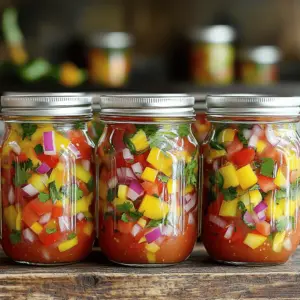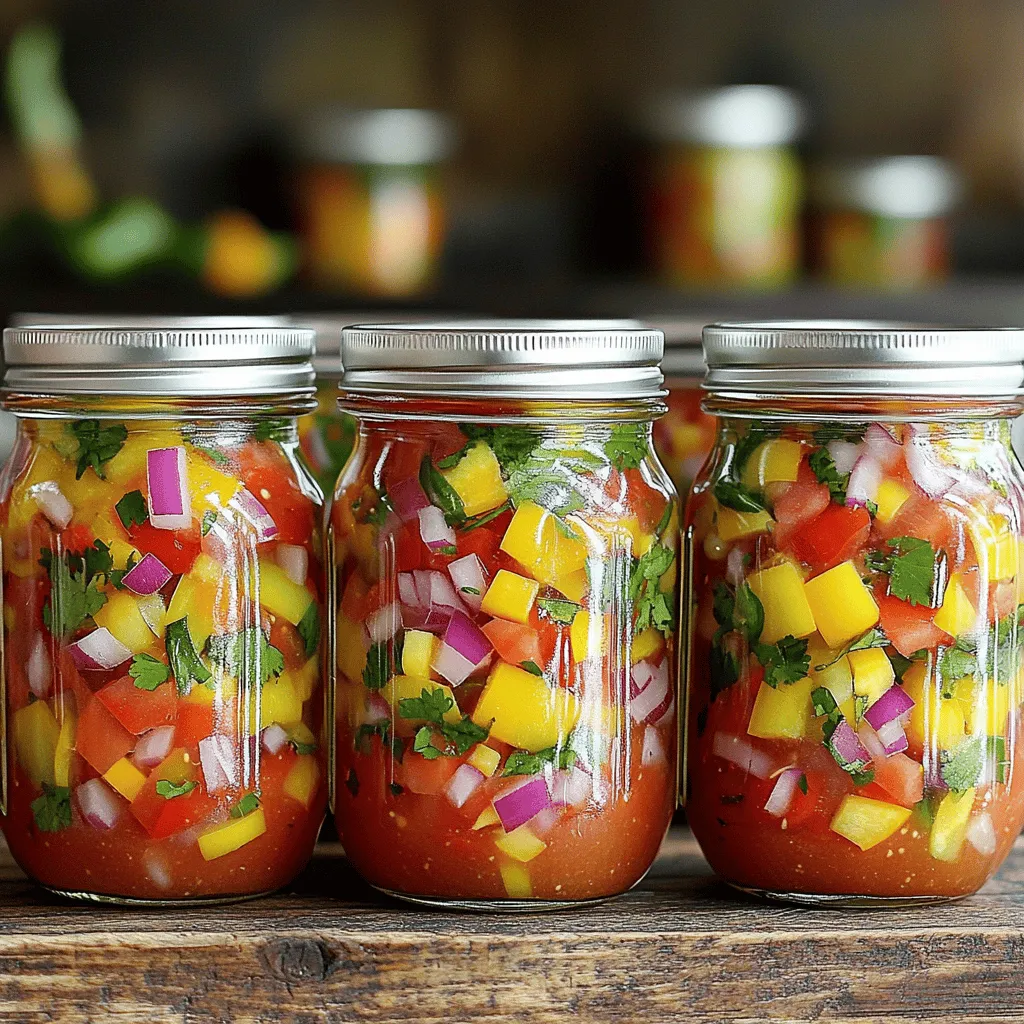Are you ready to master the art of canning salsa? With just a few simple steps, you can preserve zesty garden-fresh flavors that brighten any dish. In this guide, I’ll share my favorite ingredients, easy-to-follow instructions, and helpful tips. No experience needed! Whether you’re a canning newbie or looking to refine your skills, let’s dive in and make salsa that you can enjoy year-round.
Ingredients
Main Ingredients for Zesty Garden Salsa
– 6 ripe tomatoes, diced
– 1 medium red onion, finely chopped
– 2 cloves garlic, minced
– 1 jalapeño, seeded and minced
– 1 bell pepper, finely chopped
Seasoning and Additional Ingredients
– 1 cup fresh cilantro, chopped
– 1/4 cup lime juice, freshly squeezed
– 1 teaspoon ground cumin
– 1 teaspoon sugar
– Salt and pepper to taste
Canning Supplies Needed
– 6 pint-sized canning jars with lids
– Water for canning
Use ripe tomatoes for the best flavor. The red onion adds a nice crunch. Garlic gives a strong aroma. Jalapeño adds heat. Adjust this based on your taste. Bell pepper gives a sweet touch. Fresh cilantro brightens the dish. Lime juice adds tanginess. Ground cumin gives warmth. Sugar balances the acidity. Salt and pepper enhance all flavors.
For canning, have clean jars ready. Jars must be sterilized to keep salsa fresh. Use boiling water to sterilize jars. Ensure lids fit tightly to seal well. Use enough water for the canning process. Proper ingredients and supplies make this step easy.
Check out the full recipe for more details. Enjoy making your salsa!
Step-by-Step Instructions
Preparing the Vegetables
Start by dicing 6 ripe tomatoes. Make sure they are fresh for the best flavor. Next, finely chop 1 medium red onion. This adds a nice crunch and sweetness. Mince 2 cloves of garlic to boost the taste. For some heat, take 1 jalapeño, seed it, and mince it. If you like less spice, use less jalapeño. Always wear gloves when handling jalapeños. This helps protect your skin from the heat.
Mixing Ingredients
In a large bowl, mix the diced tomatoes, chopped onion, minced garlic, and jalapeño. Add 1 bell pepper, finely chopped, for sweetness. Toss in 1 cup of fresh cilantro and 1/4 cup of lime juice. Next, sprinkle in 1 teaspoon of ground cumin, 1 teaspoon of sugar, and salt and pepper to taste. Stir well and adjust the seasoning to match your preference.
Cooking the Salsa
Transfer your salsa mixture to a large pot over medium heat. Bring the mixture to a simmer. Cook for about 10 to 15 minutes. This allows the flavors to blend and the salsa to thicken. If you want a thicker salsa, let it simmer a bit longer while stirring.
Sterilizing Jars
Sterilizing jars is very important. It keeps your salsa safe to eat. To sterilize jars, place them in a large pot of boiling water for about 10 minutes. This kills any bacteria. Once done, carefully remove the jars and let them cool slightly.
Filling and Sealing Jars
Now it’s time to fill the jars! Use a ladle to carefully pour hot salsa into each sterilized jar. Leave about 1/2 inch of space at the top. Use a clean cloth to wipe the rim of each jar. This helps ensure a good seal. Place the lids on and screw the metal bands on until they are fingertip-tight.
Processing the Jars
Return the filled jars to the boiling water canner. Make sure the jars are covered by at least an inch of water. Process them in boiling water for 15 minutes if you’re at a high altitude. For lower elevations, 10 minutes will do. This step helps seal the jars.
Now you’re ready to enjoy some delicious, homemade salsa! For detailed ingredients, check the Full Recipe.
Tips & Tricks
Ensuring Freshness and Flavor
Best practices for selecting tomatoes
Choose ripe, firm tomatoes. Look for deep color and no blemishes. Use garden-fresh tomatoes if you can. They taste best. Overripe tomatoes can make your salsa mushy.
Adjusting spice level
If you want more heat, add more jalapeño or use serrano peppers. For milder salsa, reduce jalapeño or remove the seeds. Always taste as you go. It’s easy to add more spice, but hard to take it out.
Troubleshooting Common Canning Issues
What to do if jars don’t seal
If a jar fails to seal, don’t panic. First, check the rim for food bits. Clean it, then reapply the lid. Process it again in boiling water for 15 minutes. If it still won’t seal, refrigerate it and use it within a week.
How to fix a too-thick salsa
If your salsa turns out too thick, don’t throw it away. Simply add a bit of water or lime juice. Heat the salsa again while stirring until it reaches your desired consistency. This is a simple fix that saves your hard work.
Enhancing the Recipe
Adding other spices or ingredients
Feel free to experiment! Add cumin, oregano, or even a dash of smoked paprika for depth. Fresh herbs like basil or mint can give it a unique twist. Trust your taste buds and adjust as you like.
Utilizing leftover salsa in other dishes
Don’t let extra salsa go to waste! Use it as a topping for tacos or grilled chicken. Stir it into scrambled eggs for a tasty breakfast. You can even mix it with beans for a quick dip. There are endless possibilities!

Variations
Salsa can be fun and creative. You can make it in many ways. Let’s dive into some great variations.
Different Salsa Flavors
You can choose between chunky or smooth salsa. Chunky salsa has larger pieces of veggies. It gives a nice bite. Smooth salsa has a blended texture. This is great for dipping. You can also try fruit salsas. Mango or peach salsa adds a sweet twist. These fruit flavors work well with spicy chips.
Heat Levels
Salsa can be mild, medium, or spicy. You choose how hot you want it. For mild salsa, use less jalapeño. For medium, add one jalapeño. If you like spice, use two or more. You can also swap jalapeños with other peppers. For a sweet heat, try poblano peppers. They add flavor without too much burn.
Seasonal Ingredients
Use fresh, seasonal veggies for the best taste. In summer, add sweet corn or zucchini. These veggies boost flavor and texture. You can also use fresh herbs. Basil or parsley gives a unique touch. Don’t forget to try cilantro. It adds a bright flavor to the mix.
Explore these variations to find your favorite salsa recipe! For the full recipe, check out the Zesty Garden Salsa section.
Storage Info
Proper Storage Techniques
To store your canned salsa, keep it in a cool, dark place. A pantry works well. The ideal temperature is between 50°F and 70°F. Avoid direct sunlight, as it can spoil your salsa. Canned salsa lasts up to one year if stored correctly. Check the jars for any signs of spoilage before use.
Using Unsealed Jars
If you have unsealed jars, store them in the fridge. Use these jars within a week. You can also use partially canned salsa for dips or toppings. Try it on tacos, nachos, or as a salad dressing. It’s a great way to enjoy your fresh salsa!
Reusing Jars
You can reuse canning jars, but check them first. Look for cracks or chips, as these can cause issues. Always clean jars well before reusing. Sterilize them again to ensure safety. This helps keep your salsa fresh and tasty.
FAQs
Can I can salsa without a pressure canner?
Yes, you can can salsa using a water bath canner. This method works well for high-acid foods like salsa. Pressure canning is best for low-acid foods. With water bath canning, you heat jars in boiling water. This method keeps the salsa safe to eat. Always follow a tested recipe for best results, like the Full Recipe.
What is the best way to store opened salsa?
Open jars of salsa should go in the fridge right away. Cover them tightly with a lid. Use them within one week for best flavor. If you see any mold or off smells, throw it out.
How long can canned salsa last?
Canned salsa can last for up to a year when stored properly. Keep it in a cool, dark place. If you notice rust on the jar or any bulging lids, do not eat it. Also, check for off smells or changes in color. These are signs of spoilage.
Can I modify the ingredients in the salsa recipe?
You can change some ingredients in the salsa. For example, swap in different peppers or tomatoes. But, keep safety in mind. Always maintain the same acidity level to avoid spoilage.
What should I do if my salsa is too watery?
If your salsa is too watery, you can thicken it before canning. Simmer the salsa longer to reduce the liquid. You can also add tomato paste for a thicker texture. Just make sure to stir well as it cooks.
You now understand how to make delicious garden salsa. We covered the key ingredients, important steps, and best practices for canning. Remember to select ripe tomatoes and adjust spices to your liking. The right storage can keep your salsa fresh for months. By following these tips, you’ll enjoy tasty salsa all year. Experiment with flavors and have fun! Now, gather your supplies, and start canning your own flavorful salsa today!

